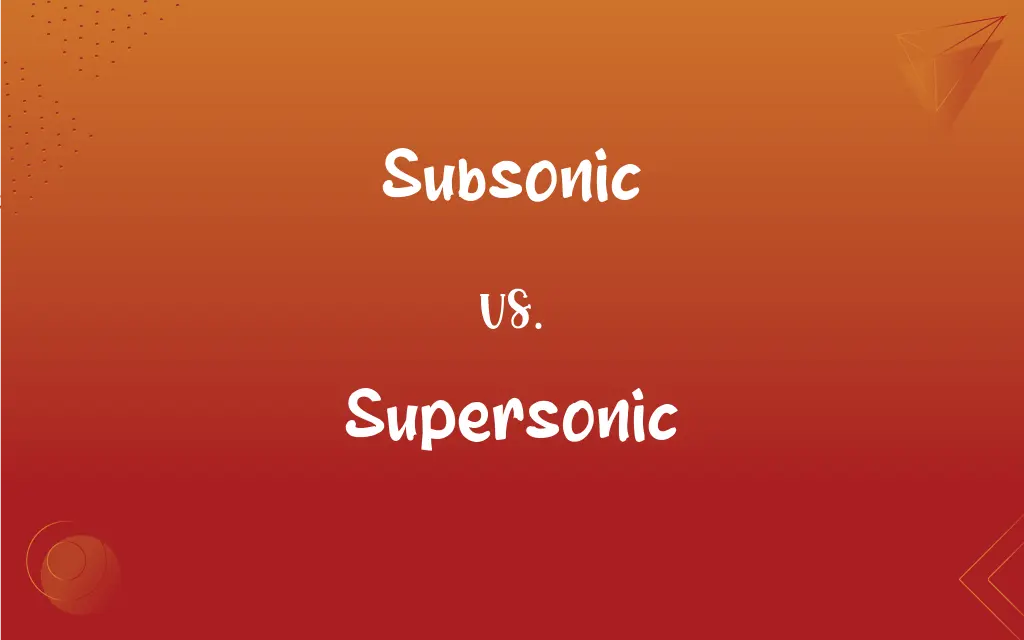Subsonic vs. Supersonic: What's the Difference?
Edited by Aimie Carlson || By Janet White || Updated on October 5, 2023
Subsonic refers to speeds less than the speed of sound, while supersonic refers to speeds greater than the speed of sound, creating sonic booms.

Key Differences
Subsonic speeds are those that are lower than the speed of sound (Mach 1). Supersonic speeds exceed this threshold, navigating beyond the sonic barrier and typically generating sonic booms, which are powerful shockwaves.
Subsonic flight takes place at a speed where air molecules can adjust (or move out of the way) smoothly, maintaining typical aerodynamic flow. Conversely, supersonic flight disrupts this flow, leading to shockwaves as it transitions through the sound barrier.
Subsonic travel might not create sonic booms, but it does offer quieter, often more energy-efficient transit. Supersonic speeds provide rapid transit, cutting travel times significantly but usually at the expense of higher energy consumption and noise.
While subsonic speeds are common for general aviation and transport, supersonic speeds have typically been associated with military jets and specialized commercial travel, given the specific engineering and energy demands involved.
Subsonic air travel is widely accessible and tends to be more economical and environmentally friendly due to lower fuel consumption. On the other hand, supersonic travel is often associated with luxury, speed, and, historically, higher costs and fuel use.
ADVERTISEMENT
Comparison Chart
Speed
Below the speed of sound
Above the speed of sound
Sonic Booms
Does not create sonic booms
Creates sonic booms
Travel Time
Generally longer
Significantly reduced
Energy Use
Typically more efficient
Typically less efficient
Common Usage
General aviation and transport
Military and specialized transport
ADVERTISEMENT
Subsonic and Supersonic Definitions
Subsonic
Subsonic refers to speeds slower than sound.
Most commercial airplanes travel at subsonic speeds to enhance fuel efficiency.
Supersonic
Supersonic refers to speeds that exceed the speed of sound (Mach 1).
The Concorde was a famous supersonic passenger aircraft.
Subsonic
Subsonic can signify a deliberate focus on energy-efficient and accessible travel.
Subsonic flight choices remain popular among environmentally conscious travelers.
Supersonic
Supersonic can allude to phenomena that generate sonic booms.
Supersonic jets often create noticeable sonic booms as they traverse the sky.
Subsonic
Subsonic can relate to aspects engineered for optimal performance below Mach 1.
Subsonic aircraft are designed to minimize noise during flight.
Supersonic
Supersonic may denote engineering and designs optimized for high-speed travel.
Supersonic aircraft feature specially designed wings to manage shockwaves.
Subsonic
Subsonic also pertains to frequencies below the range of human hearing.
Subsonic frequencies can often be felt as vibrations rather than heard.
Supersonic
Supersonic is often utilized in contexts requiring rapid transit.
Supersonic missiles are used for swift strike capabilities.
Subsonic
Subsonic may indicate a quiet or reduced noise operation.
Subsonic ammunition is developed to operate with less acoustic intensity.
Supersonic
Supersonic occasionally implies a premium, fast-travel context.
Supersonic travel is sometimes associated with high-end, rapid transit experiences.
Subsonic
Of less than audible frequency.
Supersonic
Having, caused by, or relating to a speed greater than the speed of sound in a given medium, especially air.
Subsonic
Having a speed less than that of sound in a designated medium.
Supersonic
Of or relating to sound waves with a frequency above the range audible to the human ear; ultrasonic.
Subsonic
(of a sound, scientific) having a frequency too low to be audible
Supersonic
(of a speed) Greater than the speed of sound (in the same medium, and at the same temperature and pressure).
Subsonic
(of a sound, literary) very quiet, almost inaudible
The noise of the ship was all around her. The faint subsonic rumble of the reactor and drive. (Leviathan Wakes, James S. A. Corey)
Supersonic
Ultrasonic, having a frequency too high to be audible.
Subsonic
(of a speed) (aviation) less than the speed of sound (in the same medium, and at the same temperature and pressure)
Supersonic
An aircraft that can travel at the speed of sound.
Subsonic
With a Mach number such that 0.3 < Ma < 0.8 (approximately - the exact limits vary between sources)
Supersonic
Moving at a speed greater than the speed of sound in air; - this speed varies with altitude, since the speed of sound varies with altitude, as well as with temperature and humidity, being approximately 1129 feet per second at sea level and 984 feet per second at 16 miles altitude.
Subsonic
An aircraft whose maximum speed is less than the speed of sound
Supersonic
Capable of moving at speeds higher than the speed of sound; - of aircraft.
Subsonic
(of speed) less than that of sound in a designated medium;
Aircraft flying at subsonic speeds
A supersonic bomber flies so fast that it must release its bombs while the target is still over the horizon
Supersonic
(of speed) greater than the speed of sound in a given medium (especially air);
A supersonic bomber flies so fast that it must release its bombs while the target is still over the horizon
Aircraft flying at subsonic speeds
Supersonic
Having frequencies above those of audible sound
FAQs
Can subsonic speeds create a sonic boom?
No, sonic booms are not produced at subsonic speeds.
Can subsonic be used to describe sound waves?
Yes, subsonic can describe sound waves that are below the frequency audible to the human ear.
What does subsonic mean?
Subsonic refers to speeds below the speed of sound (under Mach 1).
What is a sonic boom and does it relate to supersonic speed?
A sonic boom is a loud explosive noise caused by the shockwave generated by an object traveling at supersonic speed.
What defines supersonic speed?
Supersonic speed is when an object travels faster than the speed of sound (exceeds Mach 1).
Are subsonic flights quieter?
Yes, subsonic flights are generally quieter and don’t produce sonic booms.
Why are subsonic speeds prevalent in commercial air travel?
Predominantly for reasons related to fuel efficiency, noise reduction, and general aviation regulations.
Is supersonic flight faster than subsonic flight?
Yes, supersonic flight is faster due to speeds exceeding the speed of sound.
Are there commercial flights available that travel at supersonic speed?
Historically, yes, like the Concorde. Currently, some companies are developing new supersonic commercial jets.
Is subsonic flight more energy-efficient?
Typically, yes. Subsonic flights often consume less fuel than supersonic flights.
What challenges do engineers face when designing supersonic aircraft as compared to subsonic?
Engineers must address issues like sonic booms, heat management, and structural integrity for supersonic aircraft.
Can both subsonic and supersonic flights be used for international travel?
Yes, though subsonic is standard for commercial international travel due to its practicality and efficiency.
Does supersonic travel consume more fuel than subsonic travel?
Generally, yes. Supersonic travel often demands more energy and, thus, more fuel.
Why is supersonic flight not common in commercial aviation?
Due to factors like sonic booms, high energy consumption, and engineering complexities.
Is it possible for sound to travel at supersonic speed?
Sound travels at a set speed in a medium (e.g., 343 m/s in air at sea level), objects traveling faster than this speed are supersonic.
Is there a notable size difference between subsonic and supersonic aircraft?
Not necessarily. Size varies based on the specific design and intended use of the aircraft.
What materials are typically used in the construction of supersonic aircraft to withstand the conditions?
Materials like titanium and composites that can endure high temperatures and pressures are often used in supersonic aircraft.
Are there speeds higher than supersonic?
Yes, speeds above Mach 5 are termed "hypersonic."
Can both subsonic and supersonic speeds be achieved by the same aircraft?
Yes, some aircraft, particularly military jets, can operate at both subsonic and supersonic speeds.
Do pilots require special training to fly at supersonic speeds?
Yes, flying at supersonic speeds necessitates understanding and managing phenomena like sonic booms and high-speed aerodynamics.
About Author
Written by
Janet WhiteJanet White has been an esteemed writer and blogger for Difference Wiki. Holding a Master's degree in Science and Medical Journalism from the prestigious Boston University, she has consistently demonstrated her expertise and passion for her field. When she's not immersed in her work, Janet relishes her time exercising, delving into a good book, and cherishing moments with friends and family.
Edited by
Aimie CarlsonAimie Carlson, holding a master's degree in English literature, is a fervent English language enthusiast. She lends her writing talents to Difference Wiki, a prominent website that specializes in comparisons, offering readers insightful analyses that both captivate and inform.































































